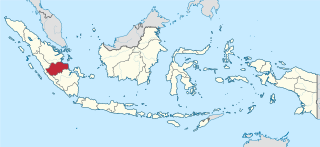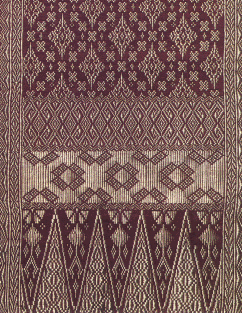See also
- Palimbang, a municipality in the province of Sultan Kudarat in the Philippines
Palembang is the capital city of the Indonesian province of South Sumatra

Sumatra is one of the Sunda Islands of western Indonesia. It is the largest island that is fully within Indonesian territory, as well as the sixth-largest island in the world at 473,481 km2 (182,812 mi.2), not including adjacent islands such as the Simeulue, Nias, Mentawai, Enggano, Riau Islands, Bangka Belitung and Krakatoa archipelago.

Palembang is the capital city of the Indonesian province of South Sumatra. The city proper covers 400.61 square kilometres of land on both banks of Musi River on the eastern lowland of southern Sumatra. It had a population of 1,668,848 at the 2020 Census. Palembang is the second most populous city in Sumatra, after Medan, the ninth most populous city in Indonesia, and the nineteenth most populous city in Southeast Asia. The Palembang metropolitan area comprises parts of regencies surrounding the city such as Banyuasin, Ogan Ilir, and Ogan Komering Ilir, with a total estimated population of more than 3.5 million in 2015.

Srivijaya was a Malay Buddhist thalassocratic empire based on the island of Sumatra, which influenced much of Southeast Asia. Srivijaya was an important centre for the expansion of Buddhism from the 7th to the 12th century AD. Srivijaya was the first unified kingdom to dominate much of the Malay Archipelago. The rise of the Srivijayan Empire was parallel to the end of the Malay sea-faring period. Due to its location, this once-powerful state developed complex technology utilizing maritime resources. In addition, its economy became progressively reliant on the booming trade in the region, thus transforming it into a prestige goods-based economy.

South Sumatra is a province of Indonesia. It is located on the southeast of the island of Sumatra, The province spans 91,592.43 km2 (35,364 sq mi) and had a population of 8,467,432 at the 2020 Census. The capital of the province is Palembang. The province borders the provinces of Jambi to the north, Bengkulu to the west and Lampung to the south. The Bangka Strait in the east separates South Sumatra and the island of Bangka, which is part of the Bangka Belitung Islands province. This province is rich in natural resources, such as petroleum, natural gas and coal. The province is inhabited by many different ethnic groups, with Palembang people the largest ethnic group. Most speak Palembang Malay, which is mutually unintelligible to both Indonesian and Standard Malay. Other ethnic groups include the Javanese, Sundanese, Minangkabau and Chinese. Most are concentrated in urban areas and are largely immigrants from other parts of Indonesia.

Jambi is a province of Indonesia. It is located on the east coast of central Sumatra and spans to the Barisan Mountains in the west. Its capital and largest city is Jambi. The province has a land area of 50,160.05 km2, and a sea area of 3,274.95 km2. It had a population of 3,092,265 according to the 2010 Census and 3,548,228 according to the 2020 Census.

Otak-otak, which literally translates as "brains" in Indonesian and Malay languages, is a Southeast Asian fish cake made of ground fish meat mixed with spices and wrapped into leaf parcels. Otak-otak is traditionally served fresh, encased within the leaf parcel it is cooked in, and can be eaten solely as a snack or with steamed rice as part of a meal.

Zapin is one of the most popular dance and musical forms in traditional Malay performing arts. Dance movements are choreographed to melodies which are performed using musical instruments such as the gambus, accordion and rebana. It is believed to have been introduced by Persian and Arab Muslim missionaries from the Middle East to Malay Archipelago around the fourteenth century where back then only males were allowed to perform; nowadays, female dancers are included. It used to be performed exclusively for religious ceremonies but through the years it has become a form of traditional entertainment, hence the participation of female dancers is allowed.

The Orang Batin Sembilan, Orang Rimba or Anak Dalam are mobile, animist peoples who live throughout the lowland forests of southeast Sumatra. Kubu is a Malay exonym ascribed to them. In the Malay language, the word Kubu can mean defensive fortification, entrenchment, or a place of refuge. It is metaphor for how the majority and dominant Islamic Melayu villagers believe them to use the interior forests as a means for resisting inclusion in the larger Malay social and Islamic religious world. As is the case with other forest peoples in the region, the term Kubu is associated with very negative connotations.

Songket is a fabric that belongs to the brocade family of textiles of the Malay world (today, Brunei, Indonesia, Malaysia and Singapore. It is hand-woven in silk or cotton, and intricately patterned with gold or silver threads. The metallic threads stand out against the background cloth to create a shimmering effect. In the weaving process the metallic threads are inserted in between the silk or cotton weft threads in a technique called supplementary weft weaving technique.
Jambi is a Malayic language spoken in Jambi province, Indonesia. It is closely related to Palembang Malay in neighbouring South Sumatra and Bengkulu Malay in Bengkulu Province.
Bengkulu or Bengkulu Malay is a Malayic language spoken on the Indonesian island of Sumatra, around the city of Bengkulu. It is more closely related to other Malay variants in Sumatra such as Col, Jambi Malay and Palembang Malay as well Minangkabau spoken in neighbouring West Sumatra than to the Rejang language, which is also spoken in the province.

Rencong is any native writing system found in central and south Sumatra, including Kerinci, Bengkulu, Palembang and Lampung. These scripts lasted until the 18th century, when the Dutch colonized Indonesia. These scripts were used to write manuscripts in native languages and in Malay, such as the Tanjung Tanah Code of Law. The Malay writing was gradually replaced by the Jawi script, a localized version of the Arabic script.

Malay Indonesians are ethnic Malays living throughout Indonesia. They are one of the indigenous peoples of the country. Indonesian, the national language of Indonesia, is a standardized form of Riau Malay. There were numerous Malay kingdoms in what is now Indonesia, mainly on the islands of Borneo and Sumatra. These included Srivijaya, the Melayu Kingdom, Dharmasraya, the Sultanate of Deli, the Sultanate of Siak Sri Indrapura, the Riau-Lingga Sultanate, the Sultanate of Bulungan, Pontianak Sultanate, and the Sultanate of Sambas.
Palembang, also known as Palembang Malay, or Musi, is a Malayic language primarily spoken in about two thirds of South Sumatra Province in Indonesia, especially along the Musi River. It consists of two separate but mutually intelligible dialect chains: Musi and Palembang. The Palembang dialect is a koiné that was born in Palembang, the capital city of South Sumatra. It has become a lingua franca throughout major population centers in the province, and is often used polyglossically with Indonesian and other regional languages and dialects in the area. Since parts of South Sumatra used to be under direct Javanese rule for quite a long time, the speech varieties of Palembang and its surrounding area are significantly influenced by Javanese, down to their core vocabularies.

Kemplang is an Indonesian traditional savory fish cracker snack commonly found in southern parts of Sumatra, Indonesia. Kemplang crackers are commonly made of ikan tenggiri (wahoo) or any type of Spanish mackerel, mixed with tapioca starch and other flavorings, sun-dried and then grilled or fried.
Col, or Lembak, is a Malayic language of Sumatra. It is spoken by around 145,000 speakers (2000) with most speakers can be found in Lubuklinggau Municipality, South Sumatra and the areas surround it all the way to Musi Rawas in South Sumatra. The speakers of this language belongs to ethnic Lembak, a small ethnic group closely related to ethnic Malays, especially those of Bengkulu and Palembang Malays. Col is closely related to Palembang Malay and Bengkulu Malay with minor differences mostly in pronunciation, the Bengkulu Malay and Palembang Malay tend to end with "o" while Col usually ends with "e". Col language has its own ISO code that is "liw".
The Palembang, Palembang Malay, or Palembangese people are a sub-ethnic group of Malays that inhabits the interior parts of South Sumatra province, Indonesia.

Pindang refers to a cooking method in the Malay and Indonesian languages of boiling ingredients in brine or acidic solutions. Usually employed to cook fish or egg, the technique is native to Java and Sumatra. The term also could refer to a specific sour and spicy fish soup which employs seasonings like tamarind. Pindang has food preservation properties, which extends the shelf life of fish products.

Balaputradeva Museum, officially the State Museum of South Sumatra Province "Balaputradeva", is an ethnographic museum located in Southern Sumatra's capital Palembang. The museum is the state museum of the Province of South Sumatra. The name Balaputradeva is derived from Balaputra, a 9th century sovereign of Srivijaya kingdom and the former head of the Sailendra dynasty whose main center was located in the vicinity of Palembang. Balaputradeva Museum displays the history and traditions of the province of South Sumatra.

Nasi minyak is an Indonesian dish from Palembang cuisine of cooked rice with minyak samin (ghee) and spices. This rice dish is commonly associated with Palembang city, the capital of South Sumatra province. However, it is also common in neighboring Jambi as far north to Medan in Northern Sumatra. In a glimpse, nasi minyak looks and tastes slightly like nasi kebuli, this is because both rice dishes are influenced by Indian and Middle Eastern cuisines, as evidence in the use of ghee and certain spices. Bumbu spice mixture being used including cardamom, anise, clove, caraway, cinnamon, onion, garlic and curry powder.